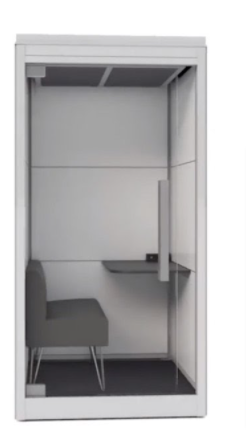Businesses have constantly strived to boost ‘employee productivity.’ However, the definition of this term has evolved over the years. Now, productivity is not only about the quantity of output but also its quality. It measures how much value the work adds to the organization.
It has been proven that the workplace environment (among other factors) has a critical role to play in boosting employee morale and productivity. Employees need to achieve various working modes at a workplace, namely focusing, learning, socializing, and collaborating with others.
In absence of a suitable work environment and the best tools, employees fail to accomplish these modes, thereby impacting their productivity.
Technology has had a big role to play in creating productive and engaging workplaces. Workspaces are no longer mere desks and chairs. We are witnessing a dramatic shift in the way workspaces are perceived. In this post, you’ll see how technology has influenced and improved workspaces for good.
1. BYOD and Desk Management Tools
For the past two years, remote work was the norm. Though most companies are getting back to offices, the remote way of working is here to stay. Companies are becoming more flexible in their expectations from employees. As a result, they are counting on technology to help their employees work from home, office, or coworking spaces.
They are adopting BYOD (bring your own device) to encourage employees to use their personal devices for work. Moreover, companies with a large remote workforce are relying on managed service providers (MSP) and desktop management tools.
2. Efficient Collaboration Technologies
Considering that most businesses are moving towards the hybrid-remote work style, collaboration technologies are the heroes of this era. Since the pandemic hit us, there’s hardly been a day when employees haven’t been active on Google Meet, Zoom, Microsoft Teams, and other conferencing technologies.
Similarly, cloud technology is becoming the pillar for remote firms. Employees are using the cloud to store important documents, use software, access servers, and interact with tools. These platforms also allow secure file transfer, dashboard sharing, and other networking.
As people return to offices, workspaces are investing in conferencing technologies and cloud collaborations that will allow them to connect with on-site and remote teams. Offices are adopting such cutting-edge technologies to foster seamless communication and transform into a hybrid workspace.
Video calling and cloud collaboration are a few technologies that are already disrupting the traditional workspaces, making more space for
3. Touchless Technologies
In most companies, touchless technology is being adopted to facilitate the current need for social distancing without interfering with business operations. Pieces of technology using gesture-based controls allow employees to operate on systems by effortlessly moving hands in a certain direction or pattern.
This technology offers security too. For instance, touchless verification is achieved through proximity-based devices that automatically unlock when employees arrive at the workspace.
Similarly, other security-minded touchless technologies operate through facial recognition, voice commands, and eye-tracking.
4. Sustainability and Wellness at Workspaces
The pandemic has made businesses more conscious of mental and physical fitness. This effect is reflected in the way modern workspaces are planned.
For instance, an increasing number of workspaces are now adopting human-centric circadian lighting solutions that replicate natural daylight and create a comfortable working environment. Low bay lighting is one type that’s hugely popular in open workspaces with low ceilings (between 12 and 20 feet).
Such innovative lighting solutions ensure the best experiences for the employees and the company as a whole, thus contributing to better productivity.
Further, businesses are working towards reducing their carbon footprint by using energy-efficient or carbon-neutral appliances and getting rid of wasteful practices. To accomplish this, firms are investing in smart systems that share important data on their green performance. The insights derived guide them in making environment-friendly decisions.
Smart control sensors have taken sustainability initiatives to the next level. Some of these sensors are easily able to adjust HVAC filtration and airflow, thereby improving the comfort and operational efficiency of systems.
A few other sensors measure data for the temperature, humidity, CO2, VOC, and sound levels, thus promoting a culture of care and wellness.
Such technologies are prime as physical and mental health remain top priorities for employees and employers. Deploying such technologies allows businesses to create workspaces that can respond quickly and seamlessly.
5. Improved Business Organization
Smart technology is helping businesses operate more efficiently and smoothly. Solutions like project management tools allow managers to effectively delegate, review, and assess tasks, thus improving the quantity and quality of the output.
These smart solutions have built-in features that allow businesses to plan their projects well and manage the available resources and budget. They can also alert teams when tasks go off track.
6. Purposefully Designed Spaces
People expect their workspaces to reflect their lifestyle, and technology is a huge enabler for this trend. Going forward, you can expect innovations going hand in hand with creating work areas that follow a lifestyle-based approach.
Modern office spaces are broken up into more purposefully designed areas that allow employees to focus, socialize, rejuvenate, or learn.
For instance, quiet zones installed in office spaces allow employees to focus on work. Similarly, concentration pods with brain-stimulating technology, digital whiteboards embedded in chairs and tables, and more are allowing employees to catch up on informal collaboration sessions.
Check out this mobile enclosed pod introduced by Philips. It’s a stand-alone office pod that’s simple to install and easy to relocate.

Source: snapcab.com
Such pods are just the tip of the iceberg. Innovators in this space are looking to deploy technologies like AR, VR, app-controlled meeting rooms, and holographic experiences to improve workspace efficiency and employee experience.
These technological advancements will play a big role in bringing together the key business focus areas like productivity, sustainability, cost efficiency, employee satisfaction, and wellbeing.
Summing Up
An increasing number of business leaders are looking for workspaces that can contribute to their productivity and revenue. Technology has a central role in creating a working environment where employees can work, concentrate, and socialize.
The information shared in this post will help you appreciate how the latest technological innovations are shaping modern workplaces.
Business & Finance Articles on Business 2 Community
(26)







